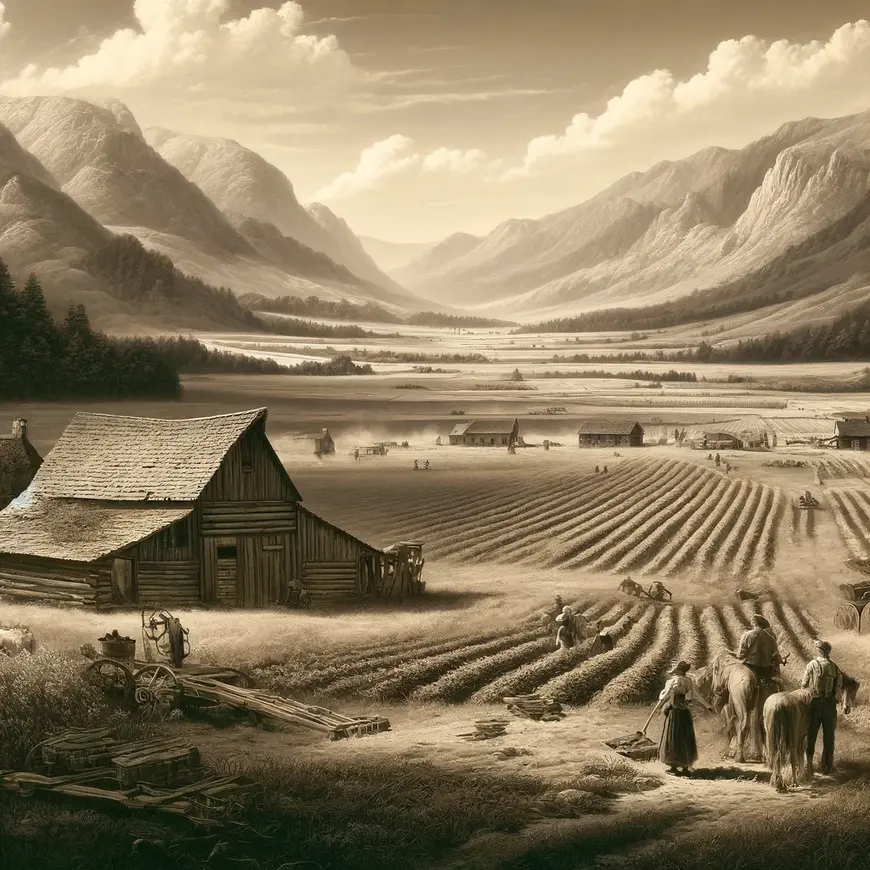A Review of John Steinbeck’s Epic “East of Eden” : the Heartland of Humanity
Steinbeck’s Magnum Opus – Navigating the Boundless Landscape of “East of Eden“
In the vast expanse of American literature, John Steinbeck’s “East of Eden” stands as an enduring epic that delves deep into the human experience. With prose as rich as the California landscape it depicts and characters as complex as the human soul, Steinbeck crafts a narrative that transcends time and place. “East of Eden” is a tale of family, morality, good and evil, and the relentless pursuit of self-discovery.
Unveiling the Bounty of the Salinas Valley: The World of “East of Eden”
Imagine a world where fertile fields stretch as far as the eye can see, where the Salinas River winds through the heart of a bountiful valley, and where the land itself seems to breathe with life. “East of Eden” immerses us in this world, the Salinas Valley of California, where the lives of two families, the Trasks and the Hamiltons, are intricately woven together over the course of generations. Steinbeck’s narrative takes us on a journey through the shifting landscape of time and place, where the valley itself becomes a character, both nurturing and unforgiving.
The setting of “East of Eden” becomes more than a backdrop; it’s a canvas upon which the characters’ destinies are painted. Steinbeck’s prose paints a vivid picture of the land and its people, creating an atmosphere that is both sweeping and intimate.

Characters in the Spotlight: “East of Eden”
At the heart of “East of Eden” lie its characters, each a unique thread in the intricate tapestry of humanity. The Trask family, with its patriarch, Adam, and his wayward sons, Charles and Cal, represents the complexities of family dynamics, love, and the eternal struggle between good and evil. Their journey mirrors the broader human quest for identity and redemption.
The Hamiltons, a neighboring family with a deep connection to the land, offer contrasting perspectives on themes of community, wisdom, and the enduring power of the human spirit. Steinbeck’s portrayal of these characters serves as a mirror to the richness and diversity of the human experience.
Themes of Good and Evil, Choice and Consequence: Insights Explored
“Unraveling the tapestry of good and evil, choice and consequence,” Steinbeck seems to say, as he delves into themes that resonate deeply with the human experience. The theme of good and evil is central to the narrative, as the characters grapple with their own moral choices and the legacy of their actions. Steinbeck’s exploration of these themes prompts readers to reflect on the complexities of human nature and the capacity for both darkness and redemption.
Choice and consequence is another prominent theme that surfaces throughout the narrative. Steinbeck’s portrayal of the characters’ decisions and their far-reaching effects serves as a testament to the power of individual choices in shaping destiny. The tension between free will and fate creates a narrative that is both profound and introspective.
Prose as a River of Emotions: Steinbeck’s Writing Style
John Steinbeck’s writing style in “East of Eden” is a river of emotions, a blend of lyrical descriptions and raw human experiences that flow through the pages. His language is both poetic and earthy, creating an atmosphere that immerses readers in the Salinas Valley and the hearts of its inhabitants. Steinbeck’s prose carries a weight that conveys the depth of human emotions and the complexities of life’s moral dilemmas.
The novel’s structure is deliberate, with each chapter revealing new layers of the characters’ lives and the unfolding drama of their destinies. Steinbeck’s writing style is a reflection of the ebb and flow of life itself, where moments of beauty and moments of tragedy are interwoven, creating a narrative that is both timeless and deeply moving.

Timeless Relevance: Today’s Reflections
While “East of Eden” is rooted in its specific time and place, its exploration of family, morality, and the human condition remains relevant in the contemporary world. In an era marked by discussions of ethics, identity, and the pursuit of meaning in a complex world, Steinbeck’s examination of these themes offers a timeless perspective.
The theme of good and evil and its connection to individual choices continues to resonate, as individuals and societies grapple with questions of ethics and morality. Steinbeck’s portrayal of the characters’ moral dilemmas serves as a reminder of the enduring complexity of human nature and the capacity for growth and redemption.
Famous Quotes from “East of Eden” by John Steinbeck
- “And now that you don’t have to be perfect, you can be good.”
- Explanation: This quote is spoken by Samuel Hamilton to Adam Trask. It reflects the novel’s theme of striving for moral goodness despite human flaws and imperfections. It suggests that accepting our imperfections allows us to focus on being genuinely good, rather than unrealistically perfect.
- “I believe a strong woman may be stronger than a man, particularly if she happens to have love in her heart. I guess a loving woman is indestructible.”
- Explanation: This quote highlights Steinbeck’s recognition of the strength and resilience of women, especially when driven by love. The character of Cathy Ames, though not loving, contrasts with this sentiment, while other female characters, like Abra, embody it, showing the various facets of strength in women.
- “Timshel! Thou mayest.”
- Explanation: This pivotal quote encapsulates the central theme of free will and moral choice in “East of Eden.” It refers to the Hebrew word “timshel,” which means “thou mayest,” signifying that humans have the choice to overcome sin and strive for goodness. This concept is crucial to the novel’s exploration of destiny, choice, and individual responsibility.
- “There’s more beauty in truth, even if it is dreadful beauty.”
- Explanation: This quote reflects the novel’s emphasis on confronting harsh realities and truths. Characters in “East of Eden” often grapple with difficult truths about themselves and others, and Steinbeck suggests that facing these truths, however painful, is essential for personal growth and understanding.
Trivia Facts about “East of Eden”
- Salinas Valley Setting: “East of Eden” is set in the Salinas Valley in California, where John Steinbeck was born and raised. The Salinas Valley, with its lush landscapes and agricultural life, serves as a backdrop for many of Steinbeck’s works, including “The Grapes of Wrath” and “Of Mice and Men.” The valley’s depiction in “East of Eden” captures its significance in Steinbeck’s life and literary imagination.
- Influence of the Bible: The novel draws heavily on the Biblical story of Cain and Abel, exploring themes of sin, guilt, and redemption. Steinbeck’s use of this story parallels how other writers, such as John Milton in “Paradise Lost,” used Biblical tales to explore complex human emotions and moral dilemmas. “East of Eden” uses the narrative of sibling rivalry and the concept of “timshel” (“thou mayest”) to delve into the nature of free will and morality.
- Literary Connections with F. Scott Fitzgerald: John Steinbeck and F. Scott Fitzgerald were contemporaries, and both authors explored the American experience in their works. While Fitzgerald’s “The Great Gatsby” focuses on the Jazz Age and the American Dream, “East of Eden” offers a more expansive view of American history and its moral challenges. Both novels critique societal values and the pursuit of personal aspirations.
- Influence of Nathaniel Hawthorne: Steinbeck admired Nathaniel Hawthorne, particularly for his exploration of moral complexity and human nature. Hawthorne’s works, like “The Scarlet Letter,” influenced Steinbeck’s thematic focus on sin and redemption in “East of Eden.” Both authors delve into the darker aspects of human character and the possibility of moral redemption through personal struggle.
Final Thoughts on “East of Eden” : A Monumental Ode to Humanity
“East of Eden” is a monumental ode to humanity that invites readers to embark on an epic journey through the heartland of the human experience, where the boundaries of good and evil blur, and where the pursuit of self-discovery is a relentless quest. John Steinbeck’s narrative is a profound exploration of the timeless questions that define our existence, and it resonates with readers on a deeply emotional and philosophical level.
As readers journey through the world of “East of Eden,” they are reminded of the power of literature to challenge our understanding of family, morality, and the human condition, to transport us to landscapes both physical and emotional, and to prompt us to reflect on the enduring complexities of our own lives. Steinbeck’s prose becomes a vessel through which readers can contemplate their own moral choices and the ever-evolving nature of the human soul. “East of Eden” is a testament to the enduring relevance of questions that have fascinated thinkers and artists for centuries, and it invites us to explore the boundless landscape of our own humanity with both reverence and introspection.
Other Reviews of Works by John Steinbeck
“Cannery Row” by John Steinbeck: A Heartfelt Novel to the Beauty of Imperfection What I take away from Cannery Row…
A Journey into Youth, Dreams, and Realities – A Review of “The Red Pony” by John Steinbeck Steinbeck’s Bittersweet Tale…
A Whimsical Tale of Friendship and Misadventures: “Tortilla Flat” by John Steinbeck “Tortilla Flat” by American Author and Nobel Laureate…
A Heartrending Tale of Friendship and Dreams – “Of Mice and Men” by John Steinbeck In the vast expanse of…
The Grapes of Wrath: John Steinbeck’s Masterpiece that captivate readers with its timeless themes My Thoughts on The Grapes of…




